
|
|
[vimeo https://vimeo.com/84906653]
|
May Love be our Lantern Flame
On the Feast of the Presentation of the Blessed Virgin Mary (21 November 2013), the Presentation Sisters, along with representatives of their Associates and Friends from around the world, gathered for a service of thanksgiving at the grave of Venerable Nano Nagle in Cork City. It was here that the ‘Lady of the Lantern’ set up her first school in 1754 and founded the Presentation Congregation on Christmas Eve 1775.
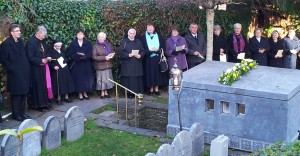 The day of celebration began with a prayer service before the mortal remains of “beloved Nano Nagle” in South Presentation graveyard.
The day of celebration began with a prayer service before the mortal remains of “beloved Nano Nagle” in South Presentation graveyard.
Presentation Sisters from home and abroad were united in this act of remembrance with local church representatives, Associates, school co-workers and those who have worked to further Nano Nagle’s cause.
Close by lay the first Ursuline Sisters Nano Nagle brought to Ireland from France (1771) as well as her first Presentation companions: Mary Hoey, Elizabeth Burke and Mary Ann Collins. Beside them, the graves of those who carried this scared flame of faith over the past 200 years.
Sr Ann Coffey addressed the gathering on behalf of the Union of the Sisters of the Presentation of the Blessed Virgin Mary. She welcomed Bishop John Buckley of Cork and Ross, Dean Nigel Dunne of St Finbarr’s Cathedral in Cork, representatives of the Ursuline Sisters, the Benedictine Sisters of Kylemore Abbey, the Mercy Sisters, Presentation and Christian Brothers, Associates of the Presentation Sisters, Friends of Nano as well as teachers and students.
“It is our great joy to be able to celebrate on the feast of the presentation of Mary – the primary feast of our congregation,” Sr Mary told all assembled on a sunny but bitingly cold morning.
“We are in a very historic part of Cork city, made holy by the faith of many generations of devout men and women, especially here at South Presentation – we are on holy ground.”
 “It is fitting that we should come here to pray and reflect at the tomb of Nano just before we go to celebrate the Eucharist. If we wish to honour Nano today, we too must commit ourselves to Eucharistic living … for the sake of the mission of Jesus,” she said.
“It is fitting that we should come here to pray and reflect at the tomb of Nano just before we go to celebrate the Eucharist. If we wish to honour Nano today, we too must commit ourselves to Eucharistic living … for the sake of the mission of Jesus,” she said.
Sr Ann Coffey then recalled that though Nano Nagle had desired that she be buried at St John’s cemetery for the poor, not too far from South Presentation, the Ursuline Sisters offered a burial plot in this garden cemetery and their offer was graciously accepted. She added, “It is fitting that we give thanks to the Ursuline Sisters.”
“They, along with the Presentation Sisters, already regarded Nano as venerable and realised that many would wish to visit her grave to pray,” she explained. Nano’s first tomb was placed at the wall that marked the boundary between the two communities of Sisters – the Ursulines and the Presentations.
In 1887, just three years after the centenary of her death, the Sisters of South Presentation moved her grave to a more central part of the cemetery and erected a celtic cross above it. This cross still stands in graveyard.
Then, on the occasion of the bicentenary of her death in 1984, the Sisters thought it fitting that a new tomb be erected and this incorporated a door through which people can touch the coffin of the saintly woman.
The tomb reminds pilgrims that while Nano now dwells in heaven, she remains close to the people on their human journey, especially those in any kind of need.
Presentation Brother, Martin Kenneally, read an extract from Bishop Coppinger’s ‘Life of Nano Nagle.’ As Sr Assumpta O’Neill of the South East Province has explained elsewhere, William Coppinger was a Bishop of Cloyne who was deeply taken with Nano Nagle’s work.
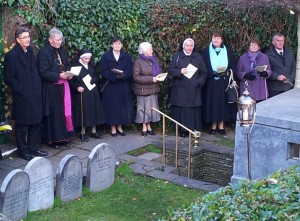 He was born in the South Parish in 1753, so he was a child during the first years of Nano’s work. Nano knew the Coppinger family well and mentions them in a letter written in April 1770 to Eleanor Fitzsimons.
He was born in the South Parish in 1753, so he was a child during the first years of Nano’s work. Nano knew the Coppinger family well and mentions them in a letter written in April 1770 to Eleanor Fitzsimons.
As a curate in South Parish, the future bishop witnessed Nano’s daily devotion to the poor of Cork.
Ten years after her death, by which time he was Bishop of Cloyne, Bishop Coppinger addressed the Cork Amicable Society in an effort to get them involved in a school for boys.
This address was later printed and is known to us as ‘Coppinger’s Life of Nano.’ To him we owe some of the intimate sketches of Nano.
Extract from ‘Coppinger’s Life of Nano’:
“Nano was destined by the Almighty to reclaim and edify thousands. Although the Penal Laws might prevent her from doing as much as she wished, they could not prevent her from doing what lay in her powers. With patience, prayer and perseverance, she entered on this great work in spite of the threat of heavy legal fines and prosecution.”
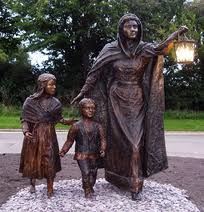 “Nano never spared herself for over 30 years. The parching heats of summer, the piercing cold of winter, had no effect on her. Her schools were her shade and her refreshment.”
“Nano never spared herself for over 30 years. The parching heats of summer, the piercing cold of winter, had no effect on her. Her schools were her shade and her refreshment.”
“How often have we seen her passing with steady composure through the rigors of every season to tend her little flock. How often have we seen her after a well spent day returning through the darkness of the night, dripping with rain, mingled in the bustling crowd, moving thoughtfully along by the faint memory of a wretched lantern, withholding from herself the necessities of life, to administer the comforts of it to others.
At chapel every day from 5am in the morning until 9am and during the divine sacrifice, how unaffected her appearance – silent, motionless, absorbed in recollection.”
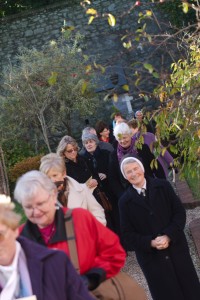 Sr Julie Watson of the South West province recalled that as a laywoman and later as the foundress of the Presentation Sisters, Nano’s life was deeply rooted in and anchored in fidelity to the gospel message.
Sr Julie Watson of the South West province recalled that as a laywoman and later as the foundress of the Presentation Sisters, Nano’s life was deeply rooted in and anchored in fidelity to the gospel message.
Although blessed with many social advantages, Nano placed everything at the disposal of the Almighty. She understood her vocation as being poor among the poor. And like her Lord, a servant of the people of God.
Sr Mary Bannon read an extract from the poem ‘Profile of Nano’ by Sr Raphael Considine. At the close of the prayer service, Bishop Buckley of Cork and Ross, and Sr Rosario blessed Nano’s tomb with holy water and the ceremony concluded with the Salve Regina.
Then led by the Army Band, everyone processed towards St Finbarr’s (South Parish) church for Mass.
Nano Nagle
(1718-1784)
Nano Nagle is one of the great pioneers of Catholic education in Ireland.
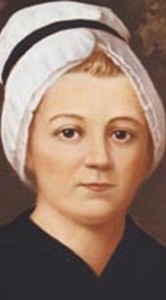 She was born Honora Nagle in Ballygriffin Co Cork in 1718, a turbulent time in Irish history due to the Penal Laws. These oppressive laws severely limited the economic, political, social, and educational rights of the Irish. It was a crime to educate and practice the Catholic faith.
She was born Honora Nagle in Ballygriffin Co Cork in 1718, a turbulent time in Irish history due to the Penal Laws. These oppressive laws severely limited the economic, political, social, and educational rights of the Irish. It was a crime to educate and practice the Catholic faith.
The Nagle family was a wealthy Catholic family and Nano had the benefit of a European education and privileged lifestyle. According to Sr Rose Forest, PBVM, a biographer of Nano, her stay in the midst of Irish Parisian society was brief, but during this time an incident took place which launched her search for meaning in her life.
“One morning the wealthy and beautiful Miss Nagle…was returning from an all-night ball. As her carriage rattled over the cobblestones of a silent street, she saw a small group of poor working people waiting in front of a church for the door to open for early Mass. The contrast between their useful lives and her own empty one, devoted to pleasure, made a lasting impression on the girl of twenty-two”.
Initially, she returned to France with the intention of joining the Ursuline Sisters there but it became apparent to both her and her spiritual director that this was not what God planned for her.
Returning to Ireland, Nano was searching for a way to help the poor she saw every day in Cork and on the family estate. She chose to devote her life to God by working with people on the margins of society.
Her mission to educate the poor began in a ‘little school’ in Cove Lane in Cork city in 1754 with an enrolment of thirty-five girls in a two-room mud cabin.
This is now the site of South Presentation convent. Within nine months, she was educating 200 girls. By 1757, she had opened seven schools, five for girls and two for boys. These provided pupils with a basic education and religious instruction.
At first alone, and later with the support of her family, particularly her uncle Joseph Nagle, she established a network of schools in Cork. In setting up schools in defiance of the established colonial order she sided with those made poor and challenged the institutional injustice that perpetuated marginalisation and poverty.
She selflessly educated the children during the day and visited and nursed the sick by night. As a result, she became known in Cork as the ‘Lady with the Lantern’, the symbol of the Sisters of the Presentation worldwide today.
Nano responded to the needs of her time and developed an educational curriculum suitable to the individual capabilities of her students. Hers was a global vision as in 1769 she wrote to a friend:
“For I can assure you, my schools are beginning to be of service to a great many parts of the world – this is a place of such trade – they heard of, and my views are not for one object alone. If I could be of service in saving souls in any part of the globe I would be willing to do all in my power.”
Nano’s words proved to be prophetic as her efforts led to the introduction of a network of schools across Ireland and beyond. As the workload increased, she realised that she would need help. She set up an Ursuline convent in Cork city which she initially sponsored.
In 1767, she stayed with the Ursuline Sisters on Rue des Ursulines in Paris while visiting her cousin Margaret Butler who had been professed just one year previously. In 1771, the first Ursuline convent was established in Ireland; the first community was made up of four Cork women, who had been professed at the Ursuline Convent in the Rue St Jacques in Paris.
However, they were unable to work for or educate the poor because at that time they were required to remain enclosed in their convents.
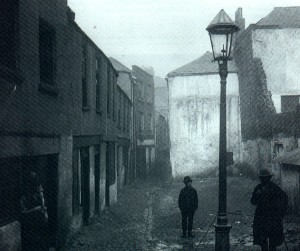 Nano then founded the Society of Charitable Instruction of the Sacred Heart of Jesus in Cork which later became known as the Presentation Sisters on Christmas Eve 1775, the culmination of 20 years of a life of devotion to the cause of improving the circumstances of others.
Nano then founded the Society of Charitable Instruction of the Sacred Heart of Jesus in Cork which later became known as the Presentation Sisters on Christmas Eve 1775, the culmination of 20 years of a life of devotion to the cause of improving the circumstances of others.
With the first members, she received the habit on 29 June 1776, taking the name of Mother Mary of St John of God. They made their first vows on 24 June 1777.
Nano Nagle died in Cork in 1784 and is buried in the grounds of South Presentation Convent, a location which has become a place of prayer and pilgrimage in her honour.
In 1791, the community was recognised by Pope Pius VI and given authority “to erect, and to form, not only in the city of Cork, but in other towns, houses for the reception of pious virgins, whose duty it should be to instruct little girls in the rudiments of faith and morals, to teach them different works peculiar to their sex, to visit sick females in the public infirmaries, and help them in their necessities”.
In 1805, it was fully established as the Presentation order, with power to take vows, and with a rule founded upon that of St Augustine.
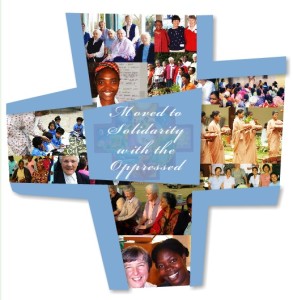 In 2000, Nagle was voted Irish Woman of the Millennium in recognition of her importance as a pioneer of female education in Ireland.
In 2000, Nagle was voted Irish Woman of the Millennium in recognition of her importance as a pioneer of female education in Ireland.
She inspired Edmund Rice, the founder of the Presentation and Christian Brothers, to bring education to the poor.
The Presentation Sisters have spread to 26 countries worldwide. To this day, the Sisters and friends of Nano remain committed to working with those most in need through a broad range of ministries.
Those ministries include spirituality and faith development, lifelong learning and innovation, social finance, social inclusion and outreach, human rights and justice, ecology and sustainable living and healthcare projects.
Sr Lucy Troy
(Interview)
In April 1978, Sr Lucy Troy PBVM made a trip by train to Cork. She had an appointment with Bishop Cornelius Lucey of Cork and Ross. “My reason for coming to Cork was to ask his permission to introduce the cause of our foundress Nano Nagle.”
At the end of the meeting, the Bishop told Sr Lucy that any permissions required to advance the cause of Nano she now had as the result of the meeting.
“I would like him to be remembered today for his graciousness and for the generosity with which he gave permission when I visited,” she told the packed South Parish during Mass on 21 November 2013.
Speaking after Mass, Sr Lucy told CatholicIreland.net that Nano Nagle is known as ‘the Lady of the Lantern’ because in the very narrow and dark lanes and streets of Cork, at a time when there was no electricity, she needed light as she went about visiting people in their homes in the evenings after she had finished her day’s teaching.
She carried a lantern in order to see her way. This has become the most emblematic image of Venerable Nano Nagle – holding a beacon of light which shed light in the darkness.
The penal laws were in full force in the 18th century, and the situation was very difficult in Ireland – children couldn’t get education and people were extremely poor. By providing education, Nano Nagle gave people the means to help themselves.
“I think that was her great achievement,” Sr Lucy suggests. In addition, she also visited the elderly and poor. “They said that there wasn’t a garret in Cork that she didn’t know and especially those of the poor and disadvantaged. She was in touch with the people’s real needs. She also visited prisons which would have been very unusual for a woman in the 18th century,” Sr Lucy underlines.
 “She was a society lady from a very wealthy background and so she was able to afford to go to school in Paris where she was educated by the Ursulines. She came back to Ireland as an educated woman.”
“She was a society lady from a very wealthy background and so she was able to afford to go to school in Paris where she was educated by the Ursulines. She came back to Ireland as an educated woman.”
“Given her status, she should have been inclined to give alms – so what prompted her not to do that but to start schools? That would have involved having a few children around her in a room or under a tree because it was forbidden to give education publicly.”
Though the announcement that Nano Nagle had been declared Venerable came on 31 October 2013, according to Sr Lucy Troy, the twelve theologians considering her case met in October 2012 and declared that she was a woman of heroic virtue.
“So we knew that would happen and it happened after a year almost to the day.”
[vimeo https://vimeo.com/85979281]
The Mass
St Finbarr’s South Parish church is intimately linked with Nano Nagle. It is here she used to come to pray when she was not tending to the educational needs of the children or the material needs of the sick and elderly she visited.
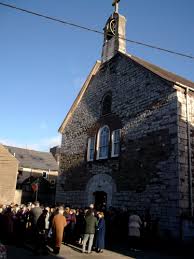 The Church was packed with members of the Presentation Sisters, Associates, co-workers, friends of Nano, teachers, students and friends. Perhaps the most symbolic presence was that of Dick Healy, a descendent of a sibling of Nano Nagle.
The Church was packed with members of the Presentation Sisters, Associates, co-workers, friends of Nano, teachers, students and friends. Perhaps the most symbolic presence was that of Dick Healy, a descendent of a sibling of Nano Nagle.
Sr Mary Hoare, Provincial Leader of the South West Province, welcomed those assembled in the pews as pupils from Scoil Aiseiri Chriost danced towards the altar bearing the flags of the countries in which the Presentation congregation is present.
“I welcome you on behalf of the Presentation Sisters to St Finbarr’s South Parish Church – the church where Nano Nagle prayed for many hours every day. We have here in the south parish an unbroken line with the Presentation Sisters from 1775. There are Presentation Sisters, associates and students in the five continents and all are linked back to South Presentation,” she explained.
Ahead of the procession of concelebrating bishops and priests who processed into the Mass to the Venerable Nano hymn, written by Sr Cecilia Molloy for the occasion, a number of symbolic items were brought to the altar.
These included soil from Nano’s birthplace in Ballygriffin, water from the rivers Blackwater and Lee in Cork, both of which were pivotal in Nano’s life. As a young child, the carefree Nano happily played in the Blackwater. Later, Nano as a mature woman of faith crossed the river Lee in her daily service of the poor, guided by the faint glimmering of her small lantern.
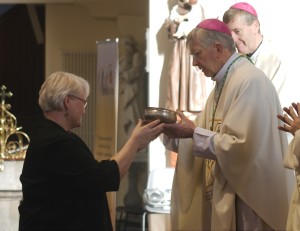 They also included an earthball, symbolising one sacred community of life and as a reminder of the people and places in our world where there is suffering as a consequence of war, greed and ecological disaster.
They also included an earthball, symbolising one sacred community of life and as a reminder of the people and places in our world where there is suffering as a consequence of war, greed and ecological disaster.
The Presentation Book of Life, which records all the names of the Presentation Sisters who have died since 26 April 1784 up to November 2013, was also brought to the altar. “They were women of listening hearts who rose and followed the Spirit’s urgings. We stand today on the shoulders of the ones who came before us. May we listen and hear life’s insistent cry to rise and follow the voice of the Spirit in our day,” Sr Mary Hoare said.
Lastly, the South Presentation Annals were laid at the base of the altar. These record the story of the Presentation congregation from its earliest days to the present. Sr Mary recalled that Annals like these have sometimes been described as “the footprints of the Holy Spirit through history.”
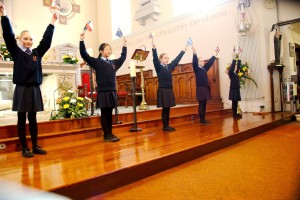 Leading the procession into the church was a figure of ‘Nano’ with her lantern and at the start of Mass, an extract from the Letters of Nano Nagle was read:
Leading the procession into the church was a figure of ‘Nano’ with her lantern and at the start of Mass, an extract from the Letters of Nano Nagle was read:
“I must say every disappointment we have had, the Almighty has been pleased to make it turn out to our advantage; though my impatience very often made (me) not submit to His divine Will as I ought. But the Almighty is all sufficient and will soon make up this loss to us. By degrees with the assistance of God we may do a great deal … It’s all in the power of the Almighty; we don’t know what is best for us and so ought to be resigned to the divine Will. The Almighty make use of the weakest means to bring about His works. He (will) do everything for the best in it, I hope.”
[vimeo https://vimeo.com/84844791]
In her reflection, Sr Lucy Troy, the Postulator for Venerable Nano Nagle’s cause, said it was “a day of great joy for the Presentation Sisters all over the world.”
She recalled how Nano, as a woman of faith, had chosen to leave behind her life as a society lady. “In her faith relationship with God, she asked herself what was the very best thing she could do for the Irish people. She answered her own question: leave Ireland, go to France, join a contemplative order and spend the rest of her life praying for the Irish people.”
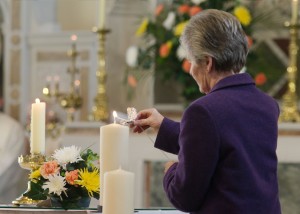 She did that but when she went there, she had no peace of mind, she tells us in her own writing. She sought external advice about the way she was feeling.
She did that but when she went there, she had no peace of mind, she tells us in her own writing. She sought external advice about the way she was feeling.
Her confessor told her, in the words of the day, that she was in great danger of losing her immortal soul if she didn’t obey the dictates her conscience.
So Nano left and came back – but she wasn’t sure to what. There was a very big difference in her coming back and in her going because she was coming back in response to God’s call. Even though she wasn’t sure at the time what He wanted from her.
In her faith, she continued to search and she was directed by God’s Spirit to begin teaching; to begin giving an education to people who had no money and she continued that throughout her life.
“Her faith in God grew stronger and her trust in God also increased. That trust increased to the extent that she was able to say on her deathbed, when she was leaving life with very little, ‘After my death the order will flourish.’”
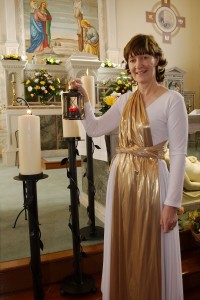 “Nano kept faith with what God had called her to do – through thick and thin – and God has kept faith with Nano to this day and with her congregation throughout the world, where people are living her charism and doing the work that God has called us to do,” Sr Lucy Troy concluded.
“Nano kept faith with what God had called her to do – through thick and thin – and God has kept faith with Nano to this day and with her congregation throughout the world, where people are living her charism and doing the work that God has called us to do,” Sr Lucy Troy concluded.
“On this day, when we thank God for what He has done through her, I ask Venerable Nano to intercede for us that we will continue with fidelity to do the work that God has called us to do especially for those who are poor.”
In her address at the close of Mass, Congregational Leader, Sr Mary Deane, PBVM, said, “With a heart full of joy and gratitude, as I stand before you on this momentous occasion, … We rejoice with Venerable Nano, aware that the harvest we reap today is born from the seeds sewn and the work of so many who have gone before us. We thank God for the gift that Nano is to us.”
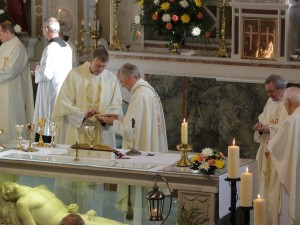 “In the shadow of where Nano Nagle set up her first small school in Cove Lane we are celebrating the enormous impact she has had on the world.”
“In the shadow of where Nano Nagle set up her first small school in Cove Lane we are celebrating the enormous impact she has had on the world.”
Sr Mary said of the declaration of Nano Nagle as a woman of heroic virtue, “It is wonderful that her legacy and life has been acknowledged by Pope Francis.”
The Congregational Leader also paid tribute to Sr Lucy Troy’s work and the sacrifices it had entailed. “In 2009, having said yes to become postulator of the cause, Lucy embarked on a new journey in which she had to learn Italian, complete a course for postulators and live in Rome.”
“Thank you Lucy for your generosity and your willingness to be of service and your work in bringing the cause of Nano to this stage. It has been said by many that no better woman could have done it. On behalf of the Presentation family around the world I express my deep gratitude to you and congratulations on a job well done!”
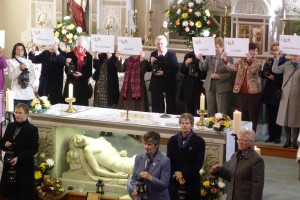 Sr Mary Deane continued, “Today we walk humbly in an echo of Nano’s footsteps as we celebrate in the church where she herself prayed more than 200 years ago and we honoured the legacy of her charism at her graveside.”
Sr Mary Deane continued, “Today we walk humbly in an echo of Nano’s footsteps as we celebrate in the church where she herself prayed more than 200 years ago and we honoured the legacy of her charism at her graveside.”
She said the most fitting tribute to Venerable Nano was for her followers to “become like her and to be bearers of light and people of faith, creativity and passion.”
“A woman deeply rooted and rounded in God, she lived, worked and walked these streets and yet her mission was for the whole world. She may not have lived to see this global enterprise which began very close to here but she believed in it.”
“Despite uncertainty and disappointment, she trusted in God and believed in his future providence – that with God all things were possible. The flame was lit by Nano here in Cork and has since been carried all over the world.”
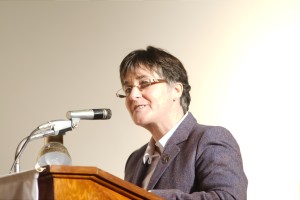 The Congregational Leader said she was deeply moved and challenged by the way that Nano’s story is being shared and lived out today by countless women and men who have been touched by her vision, her passion, and the witness of her life.
The Congregational Leader said she was deeply moved and challenged by the way that Nano’s story is being shared and lived out today by countless women and men who have been touched by her vision, her passion, and the witness of her life.
“One of the privileges of my role is the opportunity I get to visit our Sisters and communities throughout the world to see and experience the many ways that Nano’s commitment to education and the transformation of unjust systems is being lived out today in the various contexts in a world very different to hers.”
“This momentous occasion, on this our special feast day, we are invited like Mary to a joyful, wholehearted giving of ourselves to God. On this day, we are also reminded of and celebrate the mystery of our oneness, of our being in communion with God, one another and with the whole of creation.”
Representatives of the Presentation family were then called forward to receive a lantern and entrusted to carry its light to the places they represent both in Ireland and elsewhere around the world where Presentation Sisters minister.
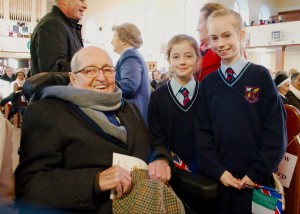 “As we continue our journey from here, all of us are called to be sparks that light other sparks so that the flame will be carried into the future in new and creative ways and into a world yearning for transformation. All of us are essential in fanning into a flame the gift of God.”
“As we continue our journey from here, all of us are called to be sparks that light other sparks so that the flame will be carried into the future in new and creative ways and into a world yearning for transformation. All of us are essential in fanning into a flame the gift of God.”
Sr Mary concluded, “We are called to continue to fan the flame of faith. May love be our lantern flame.”
After Mass, Bishop Denis Nulty, who concelebrated Mass with Bishop Buckley and Bishop Crean, told CatholicIreland.net that he was there to “support the Presentation Sisters who are doing wonderful work in the diocese of Kildare and Leighlin.”
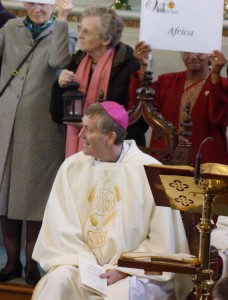 “I have Sisters practically in every county in our diocese and they are very present to the community, working with people. I am simply here to support them and I am delighted to be here. It is a wonderful day.”
“I have Sisters practically in every county in our diocese and they are very present to the community, working with people. I am simply here to support them and I am delighted to be here. It is a wonderful day.”
He said he was well aware of Nano Nagle’s charism from his parish work in the diocese of Meath both in Drogheda and Mullingar where there was “a strong presentation presence.”
He gave credit to Sr Lucy Troy’s “wonderful work” in promoting the cause of Nano in Rome. “This doesn’t happen easily and she has been hands on doing this since 1978 – so great compliments are due to her,” the Bishop said.
He added, “What we want are more Irish woman to be visionary and give great leadership in our country and move all of us forward. The charism that she possessed in her life is one that carries all of us through – men and women. This isn’t a gender issue; this is about leadership in our Church and community today.”
Bishop John Buckley, who was the main celebrant at the Mass, told CatholicIreland.net that Nano Nagle’s “name lives indelibly in the hearts and minds of Cork people.”
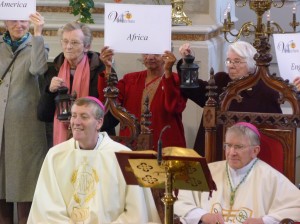 “I remember when I was growing up in West Cork, the older people there used to talk about Nano Nagle. She was associated so much with the city and her great work especially for the poor here.”
“I remember when I was growing up in West Cork, the older people there used to talk about Nano Nagle. She was associated so much with the city and her great work especially for the poor here.”
“Nano lived at a very difficult time in the history of Cork; it was a time of unemployment, mass poverty and emigration. Her dedication to the people was unremitting, despite many setbacks.”
“You saw the huge attendance today. There is a real appreciation for the work of Nano Nagle among so many Corkonians.”
Bishop Buckley described the recognition of Nano Nagle as Venerable as “a message of encouragement” to Irish women. “I think this special ceremony was a great inspiration and example for the women of Cork.”
Sr Mary Deane
Interview
[vimeo http://vimeo.com/85980498]
Sr Mary is the first English Presentation nun to lead the congregation. Her predecessor was Indian and the congregational leader before that was American.
Surprisingly, she did not know about Nano Nagle until she had entered the order.
“I got to know Nano through the sisters I encountered. I didn’t know the story but when I heard about the story I was very inspired by it. But growing up I didn’t have much contact with Presentation Sisters – that came much later.
She describes the membership of the congregation and its branches as “the living energy of Nano.”
Thanks for Vatican II’s call to go back to the roots and foundational sources, there has been “a real flowering of research and a real deepening not just of the story of Nano Nagle but what the story really means for us today.”
As to the Presentation Sisters’ hope for the beatification of Nano Nagle, Sr Mary Deane explains that while there have been “lots of miracles” they need them confirmed and formally documented by a doctor and other experts.
“We don’t have that confirmation yet but we know that there are lots of people who would say that Nano has worked miracles in so many different ways.”
“There are lots of stories – but we are still looking for confirmed miracle.”